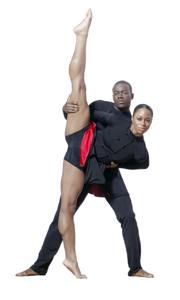
Jack Anderson
Philadelphia Energy
 |
| Corey Baker and Elisabeth H. Bell. Photo by Lois Greenfield |
Philadanco
Joyce Theater, 175 Eighth Avenue at 19th Street, Chelsea
Oct. 3-8, 2006
Tuesday and Wednesday at 7:30 p.m., Thursday and Friday at 8 p.m., Saturday
at 2 and 8 p.m., Sunday at 2 p.m., $40.
Tickets: (212) 242-0800 or www.joyce.org
Reviewed by Jack Anderson, Oct. 5, 2006
Philadanco commands the stage. Joan Myers Brown has trained her Philadelphia dancers to attract, and hold, attention, and they certainly did so at the Joyce.
Energy is the troupe's greatest asset. And it was at its energetic best in the two final offerings in a program of four group works: Daniel Ezralow's "Pulse," to music by David Lang, and Christopher L. Huggins's "Cottonwool," to music by Lamb and Jeff Storey. "Pulse" celebrated the glee of sliding, of running and sliding, tugging and sliding, hugging and sliding, gliding and sliding, spinning and sliding and, for that matter, of sliding and sliding. Yes, this was kinetic gimmickry. But that's what Ezralow intended it to be, and he invented an ingenious choreographic gadget.
"Cottonwool" was a study in turbulence. Dancers tossed and caught other dancers; groups flopped to the ground and rolled on the floor, only to pop up again jumping. In some scenes, people ran in place or scrambled about the stage at high speed, yet never seemed to get anywhere. If Huggins had an implied dramatic intention, it was possibly to depict people in perpetual motion who never quite accomplished much. But this theme was only sketchily developed, and the appeal of "Cottonwool" remained its abundant energy.
The other pieces also had more energy than substance. Carmen de Lavallade filled "Love Stories" with long-suffering women and tough, even thuggish, men and set them moving to Billie Holiday recordings. In a particularly effective juxtaposition, women forlornly clutched at a set of chairs; then, moments later, men drummed their fingers on those chairs with a mounting sense of menace. In other scenes, women became enamored of jewelry, a mirror, and a flashily dressed mannequin. But these incidents were only intermittently powerful for, although as a performer de Lavallade is blessed with great dramatic subtlety, her choreography here lacks nuance, and her characters are sketchy.
That can also be said about the agitated people in two scenes from Ronald K. Brown's "For Truth." Since the offering was frankly billed as a set of excerpts, final conclusions cannot be drawn about the this work to music by McShell Ndegeocello and Femi Kuti.
Nevertheless, too often in the program as a whole energy
alone appeared to be trying to take the place of dramatic or emotional
development.
| museums | NYTW mail | recordings | coupons | publications | classified |
